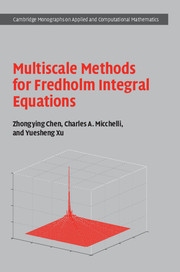Book contents
- Frontmatter
- Contents
- Preface
- List of symbols
- Introduction
- 1 A review of the Fredholm approach
- 2 Fredholm equations and projection theory
- 3 Conventional numerical methods
- 4 Multiscale basis functions
- 5 Multiscale Galerkin methods
- 6 Multiscale Petrov–Galerkin methods
- 7 Multiscale collocation methods
- 8 Numerical integrations and error control
- 9 Fast solvers for discrete systems
- 10 Multiscale methods for nonlinear integral equations
- 11 Multiscale methods for ill-posed integral equations
- 12 Eigen-problems of weakly singular integral operators
- Appendix Basic results from functional analysis
- References
- Index
7 - Multiscale collocation methods
Published online by Cambridge University Press: 05 July 2015
- Frontmatter
- Contents
- Preface
- List of symbols
- Introduction
- 1 A review of the Fredholm approach
- 2 Fredholm equations and projection theory
- 3 Conventional numerical methods
- 4 Multiscale basis functions
- 5 Multiscale Galerkin methods
- 6 Multiscale Petrov–Galerkin methods
- 7 Multiscale collocation methods
- 8 Numerical integrations and error control
- 9 Fast solvers for discrete systems
- 10 Multiscale methods for nonlinear integral equations
- 11 Multiscale methods for ill-posed integral equations
- 12 Eigen-problems of weakly singular integral operators
- Appendix Basic results from functional analysis
- References
- Index
Summary
The purpose of this chapter is to present a multiscale collocation method for solving Fredholm integral equations of the second kind with weakly singular kernels. Among conventional numerical methods for solving integral equations, the collocation method receives more favorable attention from engineering applications due to its lower computational cost in generating the coefficient matrix of the corresponding discrete equations. In comparison, the implementation of the Galerkin method requires much more computational effort for the evaluation of integrals (see, for example, [12, 19, 77]). Nonetheless, it seems that the most attention in multiscale and wavelet methods for boundary integral equations has been paid to Galerkin methods or Petrov–Galerkin methods (see [28, 64, 95] and the references cited therein). These methods are amenable to the L2 analysis and therefore the vanishing moments of the multiscale basis functions naturally lead to matrix truncation techniques. For collocation methods, the appropriate context to work in is the L∞ space, and this provides challenging technical obstacles for the identification of good matrix truncation strategies. Following [69], we present a construction of multiscale basis functions and the corresponding multiscale collocation functionals, both having vanishing moments. These basis functions and collocation functionals lead to a numerically sparse matrix presentation of the Fredholm integral operator. A proper truncation of such a numerically sparse matrix will result in a fast numerical algorithm for solving the equation, which preserves the optimal convergence order up to a logarithmic factor.
In Section 7.1, we describe multiscale basis functions and the corresponding functionals needed for developing the fast algorithm. Section 7.2 is devoted to a presentation of the multiscale collocation method. We analyze the proposed method in Section 7.3, giving estimates for the convergence order, computational costs and a bound of the condition number of the related coefficient matrix.
Multiscale basis functions and collocation functionals
Multiscale collocation methods require availability of multiscale basis functions and collocation functionals which have vanishing moments of certain degrees.
- Type
- Chapter
- Information
- Multiscale Methods for Fredholm Integral Equations , pp. 265 - 299Publisher: Cambridge University PressPrint publication year: 2015

